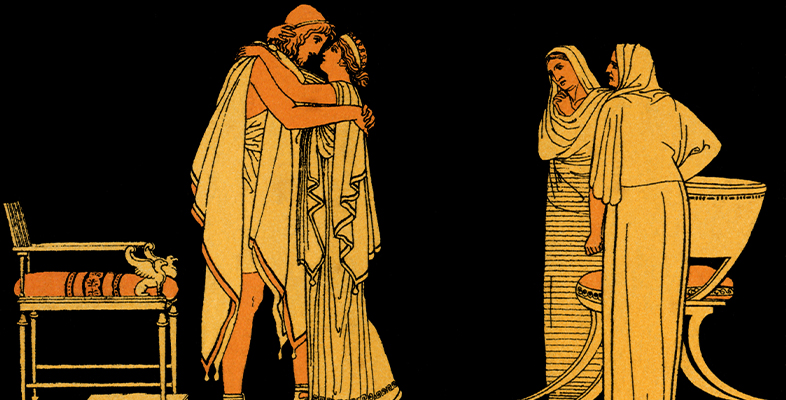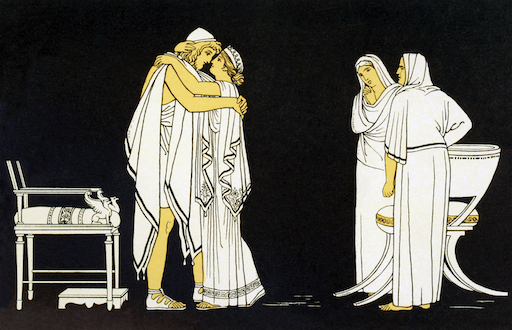4.4 Penelope and Odysseus reunited
In the next activity you will read some more of the reunion scene between Penelope and Odysseus, in which the poet uses a detailed simile – a figure of speech in which one thing is compared with something different – to describe the couple’s first embrace. Extended similes like the one you will read in Activity 8 are, like the epithets you learned about in Section 3.2, another distinctive characteristic of Homeric poetry. By drawing comparisons between the scene or person being described and something else from a very different context, the poet adds richness and depth to his work. As well as creating vivid images in the mind of the audience, similes like the one you are about to read can also highlight key themes of the text as well as important aspects of particular characters.
Activity 8
Read the following passage (Odyssey 23.231–240), which describes Penelope’s response when she realises that the man in front of her is really Odysseus. The simile starts at line 233, with the words ‘As welcome as…’ introducing the comparison between the reunion scene and the response of sailors who reach dry land after a shipwreck.
So she spoke, and aroused in him a greater desire to weep;
he wept, holding his heart-gladdening, faithful wife to him.
As welcome as the sight of land appearing to swimmers,
men whose strong-constructed ship, driven by winds
and heavy seas, Poseidon has shattered in open waters— [235]
only a few escape the grey sea by swimming to the shore,
their skin covered with a think crust of brine, and with joy
they set foot on land, for they have avoided a grim death—
just so did Penelope look with joy upon her husband, and
would not quite release her white arms’ hold on his neck. [240]
Then consider the following questions and, rereading the passage as many times as you wish, jot down a sentence or two in response to each.
- What emotions does the simile convey?
- Why do you think the poet chose to use an image of shipwrecked sailors as the point of comparison here?
- Notice what happens in line 239. Did you find anything surprising about this line?
Discussion
- The overwhelming emotion here seems to be one of relief, like that of shipwrecked sailors who have seen land. The poet also directly mentions ‘joy’ in line 237.
- The image of shipwrecked sailors seems particularly appropriate in a poem which spends a lot of time focusing on Odysseus’ journey at sea and his attempts to get home, which have been thwarted at times by the sea god Poseidon (who is also mentioned in line 235). Here the poet brings the domestic scene in front of us, and the background to Odysseus’ story, together using this simile.
- Were you surprised to find that the simile was referring to Penelope’s emotions here rather than to those of Odysseus? After all, he is the character we know as a sailor, whereas Penelope has been firmly on dry land throughout the poem.
The simile which you just read in Activity 8 is one of several such similes used in the Odyssey, where a woman is compared to a man. In this scene the poet confounds the audience’s expectations by revealing only after giving the description in the simile that he is describing Penelope’s response rather than that of Odysseus. By doing this he frames Penelope’s experiences in a way which seems to suggest that, despite the difference in context, they are of equal importance to those of Odysseus. In reversing conventional gender roles, the simile draws attention to the fact that Penelope too, as the waiting wife, has been through a distressing ordeal of her own in Odysseus’ absence. We might even go so far as to suggest that, in all that she has endured, and in the resourceful ways she has tackled the problems she has faced, she has become something of a hero too.
Yet despite this apparent acknowledgement of Penelope’s own trials, there is still much less space devoted to her story than to Odysseus’. After this embrace the couple retire to bed where they reconnect through sex and conversation (Odyssey 23.295–301). In what follows, each shares their own version of the events which have taken place while they have been apart; the poet gives an edited-down summary of the plot of the whole poem (although Odysseus’ retelling of his story here carefully glosses over his own infidelities). Here Penelope’s story is summarised in only four lines (23.302–305); by comparison, despite the fact that much of the poem so far has focused on Odysseus’ exploits, the recap of his escapades occupies thirty-two lines. It seems, then, that the heroism of the male adventurer is still thought to be more important and interesting than that of his wife back home.

